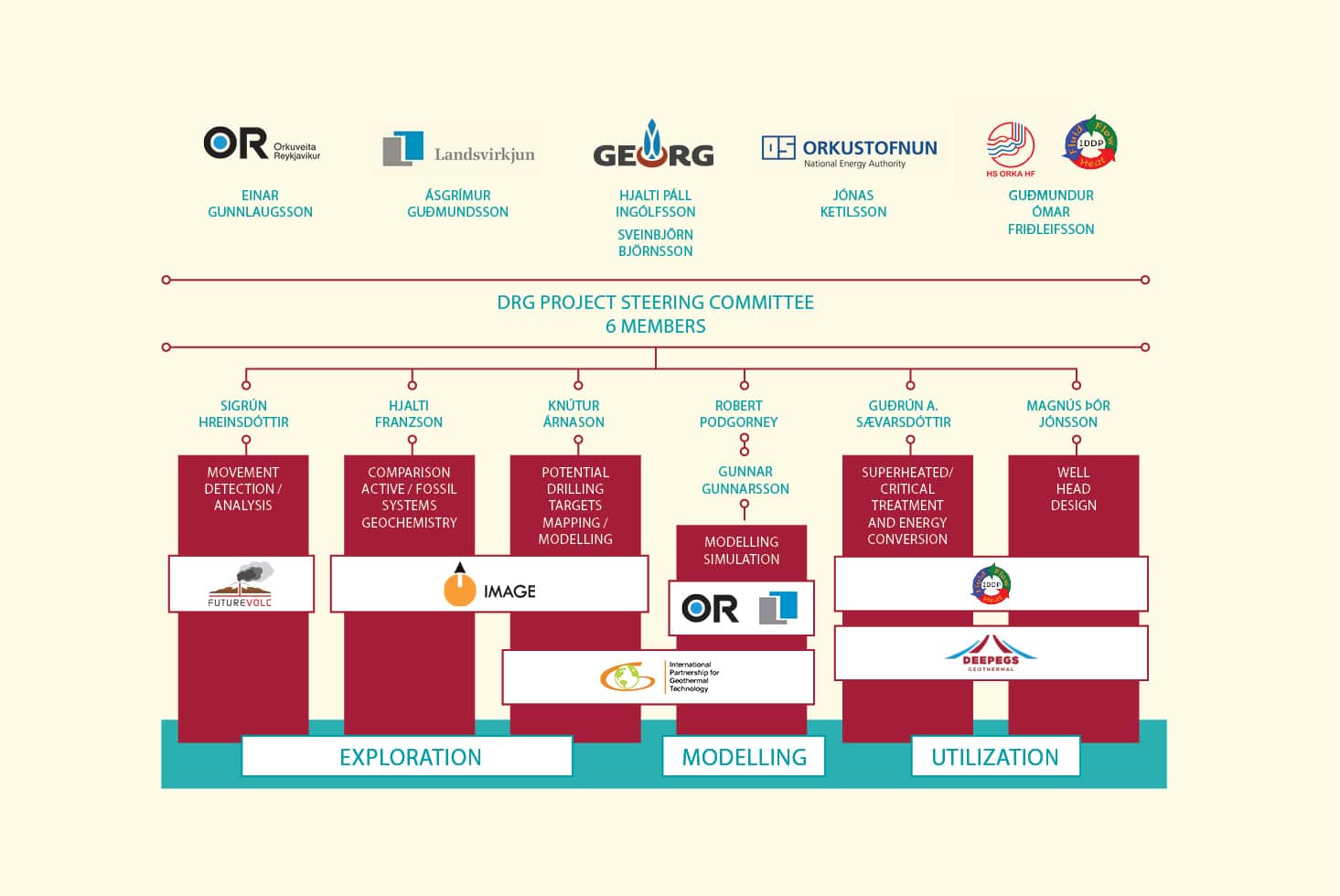The aim of the DRG project is to understand the relationship between water and magma in the roots of volcanoes and how heat is transferred into geothermal systems to maintain their energy. The latest technology will be applied in surveying, resistance measurements and seismic measurements, petrology, and geochemistry. In addition, new simulation models will be developed. These models will be used to simulate heat transfer and operation of geothermal boreholes for high-temperature steam. Furthermore, the design of wells and wellheads for high temperatures will be a focus of the project, as will methods for utilizing superheated steam from greater depths.
The research work is divided into three separate, but interconnected parts; Exploration, Modelling, and Utilization. The project consortium is a team of highly competent
individuals from universities, research institutes, energy companies and engineering companies, building a strong bond between academia and industry.
Total GEORG SUPPoRT
ISK 33 m
Total Project Cost
ISK 194 m
DRG Pre-project Seminars
The DRG Project would not have appeared if not a set of seminars and hard work of principal investigators in years before whom had a big influence on the final outcome. Seminars were archived as videos categorized below.
Opening address by the Chair Jónas Ketilsson
Task 1: Heat transfer from magma intrusions under geothermal systems Magnús Tumi Guðmundsson, University of Iceland
Task 2: Boundary conditions and roots of the geothermal systems Gunnar Gunnarsson, Reykjavik Energy
Task 3: Reservoir parameters Hjalti Fransson, Iceland GeoSurvey
Task 4: How to estimate production capacity of green fields Héðinn Björnsson, Iceland GeoSurvey
Task 5: Intrinsic or structural anisotropy Snorri Páll Kjaran, Vatnaskil Consulting Engineers
Task 6: Coupling reactive transport to reservoir modelling Edda S. P. Aradóttir, HI/ Reykjavik Energy
Task 7: Relative permeabilities for two-phase flow in geothermal reservoirs María S. Guðjónsdóttir, HR/HÍ
Task 8: Mathematical modelling of energy flow in a geothermal reservoir Halldór Pálsson, University of Iceland
1.Video clip: The test began by opening a 4″ valve into a separate flow line. This lasted for about 10 minutes https://vimeo.com/28453617
2. Video clip: This video clip shows the flow condition ca. 3 minutes after the 12″ operating valve had been fully opened into the 500 mm flow line and the rock muffler. The steam turned black after ca. 1 min. flow due to Fe-O-S-compounds from the corroded liner. https://vimeo.com/28453831
3. Video clip: After ca. 10 min. flow on the main flow line the steam turned white again and became superheated ca. 25-30 min from the beginning of flow test 4. https://vimeo.com/28453850
4. Video clip: This video clip shows the transparent superheated steam flow ca. 12 h after opening. T: 410°C, P: 40 bar, H: 3150 KJ/Kg, Power output potentially 30-40 MWe. The well was closed 11. August for modification on the flow line. Wet scrubbing pilot test will begin on mid-September 2011. https://vimeo.com/28453873
Kristján Sæmundsson
Anette K Mortensen
Þráinn Friðriksson
Sigurður H. Markússon
Kristján Ágústsson
Sigríður Sif Gylfadóttir
Guðmundur Ómar Friðleifsson
Þóra Árnadóttir
Ragna Karsldóttir
Ólafur G. Flóvenz
Þráinn Friðriksson
Geir Þórólfsson
Jónas Elíasson – summary and discussion
DRG Projects Overview
The Exploration Part of the DRG project is focused on identification and exploration of the deep roots of geothermal systems, with the aim to improve understanding of the nature of the boundary layer between magmatic intrusions and geothermal reservoirs. The project is divided into three subprojects: i) What can be learned from sites where fossil roots of the geothermal system have been exposed, ii) How can the boundary layer be imaged with seismic techniques, and iii) How can crustal deformation studies complement traditional exploration methods. The work within the first subproject of the DRG project in this respect is complemented with several other projects, including a petrographic study on the occurrence of garnets within the geothermal system, on the character of the
hornfels, and a comparison with similar rocks observed, for example, in wells in Hellisheiði, and a project on evaluation of the infiltration of fluid into the intrusion through an isotopic study. Another subproject of DRG Part 1 uses seismic methods to study the roots of an active geothermal area, with the Krafla volcano and its geothermal system selected as a case study. The purpose is to study and map velocities of both S- and P-waves in and around the geothermal system in the Krafla volcano. Lastly, the third subproject of DRG Part 1 utilizes the Krísuvík geothermal area for a study of crustal deformation in geothermal areas. The project has mapped in detail repeated inflation and deflation periods in the Krísuvík geothermal area using both GPS geodesy and interferometric analysis of synthetic aperture radar images (InSAR).
The aim of Modelling Part of the DRG project is to aid in the advancement of the methods that can be applied in the modelling of the physical processes occurring in the roots of volcanic geothermal systems, with the purpose of illuminating the overall process controlling the upwards heat transfer from the heat sources as well as improving and advancing the methods that are applied in conventional geothermal reservoir modelling and, consequently, used for geothermal resource management. The heat transfer from the roots up to shallower levels is a complicated process involving the flow of magma, the flow of fluids (two-phase and/or supercritical water), and heat transfer as well as thermo-elastic rock mechanics and chemical processes.
In conventional models of the geothermal reservoir, used for assessing capacity and for management purposes during utilization, heat sources are idealized as a steady inflow of mass and energy, at relatively shallow depth, at the bottom of the models. There is, however, need to incorporate the heat sources more accurately in the models, both as specific intrusions in contact with the fluid circulation in the geothermal systems below the production reservoirs and their highly transient nature. The Exploration Part of the DRG project is extensively based on general conceptual models emerging from Part 1 of the project.
An essential part of utilizing geothermal fluid from the earth’s core is to transfer the fluid from the deep roots of the geothermal system towards the surface, utilize the energy to produce electricity, and reinject the fluid back into the earth. The main goal of this research is to develop a method to utilize the high enthalpy geothermal fluid which comes from drilling into deep geothermal systems. For efficient utilization design and reliable operations of the power plant and associated equipment, the extreme characteristics of the high enthalpy fluid have to be considered. For example, special considerations have to be made when selecting materials and designing the system which transports the fluid to the surface equipment.
The challenges within this project are extensive but for a scope which can be managed within the frame of the DRG project, it has been divided into two parts. The objective of the first part is the design of a power process for energy utilization of high enthalpy geothermal steam with thermal, chemical and material considerations in mind. For that purpose, corrosion studies in simulated deep geothermal environment are also included in the first part. For the second part the main objectives are discussing the mechanics of materials for deep root equipment, corrosion, erosion, thermal and mechanical stresses, failure analysis and improvements in design.
Final Reports
Duration: Three years
Coordinator: Hjalti Franzson
Start date: July 2013
Duration: December 2017
Partners: Hjalti Franzson, James Brett, Moneer Altenhary, Enikö Bali, Haraldur Sigurjónsson, Guðmundur Heiðar Guðfinnsson and Guðmundur Ómar Friðleifsson
Coordinator: Knútur Árnason
Start date: 1.7.3013
Duration: Three years
Partners: Uppsala University, Cornel University, Landsvirkjun, Orkustofnun, Orkuveita Reikjavíkur, HS Orka
Project ID: 13-05-004
Coordinator: Guðni Axelsson/Robert Podgorney
Start date: 01.07.2013
Duration: 3 years
Partners: Iceland GeoSurvey, Verkfræðistofan Vatnaskil, Landsvirkjun, Orkuveita Reykjavíkur, Háskóli Íslands, HS Orka, Orkustofnun, Idaho National Laboratory (USA)
Project ID: 13-5-006
Coordinator: Guðrún Sævarsdóttir
Start date: 01.11.2014
Duration: 3 years (+ 6 months)
Partners: Reykjavik University, University of Iceland, HS Orka, Landsvirkjun, Mannvit
***
Project ID: Part 3.2
Coordinator: Magnús Þór Jónsson
Start date: 01.09.2013
Duration: Three years
Partners: Guðrún Sævarsdóttir, HR; Sigrún Nanna Karlsdóttir, HÍ; Kristinn Ingason, Mannvit; Geir Þórólfsson, HS; Kristján Einarsson, LV; Ingólfur Ö. Þorbjörnsson



